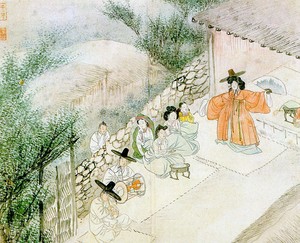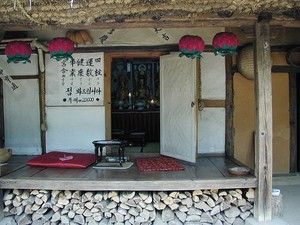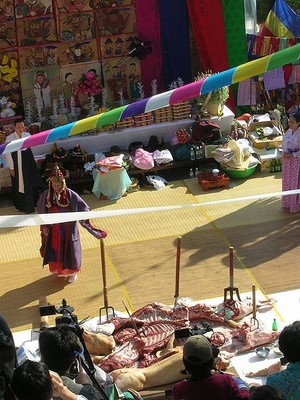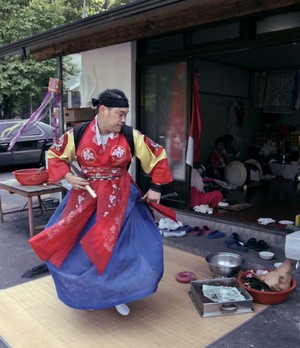Korean shamanism, today known as Muism (Mugyo, "religion of the Mu") or sometimes Sinism (Shingyo, "religion of the gods", with shin being the Korean character derivative of the Hanja),[3] encompasses a variety of indigenous religious beliefs and practices of the Korean people and the Korean sphere. In contemporary South Korea, the most used term is Muism and a shaman is known as a mudang (무당, 巫堂) or Tangol (당골). The role of the mudang, usually a woman, is to act as intermediary between a spirit entity, spirits or gods and human beings.
Women are enlisted by those who want the help of the spirit world. Shamans hold gut, or services, in order to gain good fortune for clients, cure illnesses by exorcising negative or 'bad' spirits that cling to people, or propitiate local or village gods. Such services are also held to guide the spirit of a deceased person to higher realms.

The government has discouraged belief in shamanism as superstition and for many years minimized its persistence in Korean life. Yet in a climate of growing nationalism and cultural self-confidence, the dances, songs, and incantations that compose the gut have come to be recognized as an important aspect of Korean culture.
Beginning in the 1970s, rituals that formerly had been kept out of foreign view began to resurface, and occasionally even the manager of a Western-style hotel or other executive could even be seen attending a shamanic exorcism in the course of opening a new branch in Seoul. Some of these aspects of gut have been designated valuable cultural properties that need to be preserved and passed on to future generations.

The future of shamanism itself was uncertain in the late 1980s. However, observers believed that many of shamanism's applications would probably be performed by the psychiatric profession as the government expands mental health treatment facilities in the future.
Mudang

Mudang can be categorized into two basic archetypes: sessǔmu, who inherit the right to perform the shamanic rituals and kangshinmu, who are initiated into their mudang status through a ceremony. Sessŭmu historically lived in the southern part of the Korean peninsula, while kangshimu were found throughout the peninsula and contiguous areas inhabited by Koreans, but were mostly concentrated in the north (modern day North Korea) and the contiguous areas of China and the central part of the peninsula around the Han River.
Shinbyeong (spirit sickness)
The central feature of a shaman's initiation is her affliction with an illness known as a shinbyeong. This is also called the "spirit sickness" or "self-loss" and characterized by a loss of appetite, insomnia, visual and auditory hallucinations. A ritual called a naerim-gut cures this illness, which also serves to induct the new shaman.
Rituals or gut (굿)
The gut is a shamanic ritual during which the shaman offers a sacrifice to the spirits. Through singing and dancing the shaman begs the spirits to intervene in the fortunes of the humans in question. The shaman wears a very colourful costume and normally speaks in trance. During a gut a shaman changes his or her costume several times.

There are three elements of a gut. Firstly, there are the spirits as the object of folk beliefs. Secondly, there are the believers who pray to those spirits. Finally, there is the shaman mediating between the two.
The actual form of gut varies between regions. The unfolding and style of the shamanic rite depends largely on the objective of the ceremony. The individual character and abilities of the shaman bring a unique character to the respective ritual to be performed.

Log in to write a comment